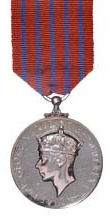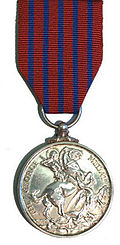George Medal
The George Medal (GM) is the second level civil decoration of the United Kingdom.
The following police officers from Liverpool have been awarded the George Medal:
30th May 1941
Constable Edward Crann, Police Constable – Liverpool City Police.
During an air raid Constable Crann extinguished fires at a warehouse and an office, and was assisting the A.F.S. at another fire when a high explosive bomb dropped on the building. This caused the whole of the premises to collapse and become a raging inferno. See Edward Crann
June 7th 1941
Sgt Harold Frederick CLAYDON – Liverpool City Police
When bombs demolished houses several people were trapped, Sgt CLAYDON, tunnelled 20ft and rescued two women. He then shored up the tunnel with wood and masonry and released another woman who was buried. The sergeant owing to his exertions in a gas-laden atmosphere, was overcome and had to rest. He recovered and returned to the tunnel and continued his rescue work. A large piece of wood was blocking the passage, he obtained a saw, crawled into the space again, and lying on his stomach sawed through the block and was able to release two casualties. Removing more debris he freed a child and a man and cleared a space so that others could rescue those remaining. CLAYDON showed exceptional courage and by his efforts 10 persons were rescued. See Harold F. Claydon
Aug 1st 1941
Liverpool Police Officers feat of strength and endurance
A feat of strength and endurance has won George Medals for three Liverpool police officers and a rescue worker.
Sergeant Christopher John GARTLAND – Liverpool City Police
Constable Herbert Frederick Collier BAKER – Liverpool City Police
Constable John Edward Willington UREN – Liverpool City Police
Thomas TOLEN, member A.R.P, rescue party, Liverpool
During an air raid a building was demolished by enemy action. Portions of the interior walls collapsed, and the outside wall was leaning dangerously inwards. GARTLAND, BAKER and UREN, accompanied by TOLEN, entered the building and after searching in complete darkness they found a fire-watcher trapped and almost buried under the debris on the ground floor. When some of the wreckage had been removed a large wooden beam, which was carrying the weight of debris of the roof and upper floor, and which was directly over the trapped man, appeared about to collapse. Constable UREN at once got under the beam, supporting it with his shoulder. He remained in this position for a considerable time, during which the other three men worked frantically to free the victim. The weight of the beam became too much for UREN to support, and BAKER took up a position beside him. It was clear that the whole building might collapse at any moment, and the sergeant who is a man of exceptional strength placed his arms around the man’s body and with powerful and sustained effort pulled him clear of the debris. Constable BAKER then got away from the beam, but owing to the great weight UREN was unable to move. The sergeant took hold of him and snatched him away. As he did so the upper floor collapsed completely covering the place where the rescuers had been working. During the whole of this time TOLEN had been untiring in his efforts to release the trapped man, entirely regardless of the near danger. Constables UREN and BAKER, by supporting the beam for over an hour, made the rescue possible. Had they collapsed under the severe strain the rescuers and rescued would have been killed.
Constable Charles Leslie CAIRNS – Bootle police force.
During an air raid a shelter together with its occupants was blown into the rafters of a house. Under the leadership of Police Constable CAIRNS rescuers climbed to the damaged roof and lowered the victims to the ground. During this time adjacent houses were on fire and bombs dropped near by shaking the roof, which was in a very dangerous condition. The constable fell through on two or three occasions but recovered himself and carried on until the rescue work was completed. It was due to the initiative and energy of Police Constable CAIRNS that the rescues were achieved
Constable James TARBUCK – Liverpool City Police
High-explosive bombs demolished many houses and trapped a number of people. Constable TARBUCK who was off duty, was engaged in extinguishing the incendiary bomb on the roof of a building. He was blown to the ground by the blast of the bomb and injured his left kneecap. Despite his injury he immediately went to the incident and organised a rescue party of volunteers. Under his direction and leadership ten people were rescued alive from the debris. During these operations the district was subjected to a very heavy bombardment
3rd of OCTOBER 1941
Daniel John Collins, Police Sergeant – Liverpool City Police
A shop, with house quarters above, was demolished by a bomb. The occupier’s wife and two children were trapped in the cellar by a large quantity of debris. Sergeant Collins began tunnelling and after
strenuous efforts reached the casualties. Portions of the building were continually falling, there was an escape of coal gas and the wreckage was on fire. In spite of these dangers, the Sergeant redoubled his efforts and, with other help, the three persons were eventually released. Collins’ excellent work, performed with total disregard of his own safety, was instrumental in saving three lives.
7th of OCTOBER, 1941
Constable Percy Albert Jones Green – Liverpool City Police
Constable Frederick Albert Spicer – Liverpool City Police
During an air raid a dock shed caught fire. The shed contained a cargo of army stores, including explosives. Immediately outside were railway trucks loaded with ammunition and moored alongside the quay was a motorvessel containing a similar cargo. The fire spread rapidly towards the stores and the ship.
Constables Green and Spicer gave directions for the ship to be moored on the other side of the dock, cast off the mooring ropes and then began the gigantic task of removing ammunition and stores to a safe place.
A Police party arrived and the ammunition trucks were pushed out of the way.



